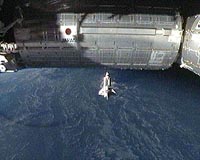 |
Greenbelt MD (SPX) Jul 28, 2010 What if work performed in space could improve the treatment of household and nuclear waste on Earth? That's what investigators are hoping to do with the results of a fluid physics study in progress on the International Space Station. The experiment, called DECLIC-HTI, is studying supercritical water that could lead to spin-offs in the field of clean technologies for treating waste here on Earth. A supercritical fluid is any substance at a temperature and pressure above its critical point - the point at which the fluid is one homogeneous phase and exhibits properties of both liquids and gases. In this form, the substance can flow through solids like a gas and dissolve materials like a liquid. Water and carbon dioxide are the most commonly used supercritical fluids. Using extremely high temperatures, supercritical water can completely break down waste into benign forms. DECLIC, or DEvice for the study of Critical LIquids and Crystallization, is a miniaturized, automatic thermo-optical laboratory that studies transparent fluids by finely tuning the temperature of a sample and sending images and video to the ground. The HTI, or high temperature insert, can measure fluid temperatures up to 400 degrees Celsius. For the experiment, astronauts plug an insert, containing the water sample cell, into the DECLIC payload. The sample is precisely heated and observed in real time by investigators on the ground. "These phenomena will be of interest to understand the behavior of supercritical fluids in space, but also to improve industrial processes on the ground," said Gabriel Pont, DECLIC mission manager with the CNES, or Centre National d'Etudes Spatiales, in Toulouse, France. "A typical example is burning completely organic or industrial waste in supercritical water at a much lower temperature than in conventional systems, thus saving energy and being cleaner. Microgravity will provide the ideal environment to understand how to do that." The supercritical water temperature is very sensitive to gravity and has never been measured in microgravity conditions. "We expect HTI to give us the best measurement of this temperature ever found," added Pont. The experiment began in October 2009 when the High Temperature Insert commissioning was performed. Since then, four experimental sequences have been performed, leading to more than 80 running days. "We are very excited about what we've seen thus far, and cannot wait to see the potential benefits of our work on Earth," added Pont.
Share This Article With Planet Earth
Related Links NASA's Marshall Space Flight Center Station at NASA Station and More at Roscosmos S.P. Korolev RSC Energia Watch NASA TV via Space.TV Space Station News at Space-Travel.Com
 Ball Aerospace And LockMart Demo New Docking System Technology
Ball Aerospace And LockMart Demo New Docking System TechnologyBoulder CO (SPX) Jul 27, 2010 Ball Aerospace and Technologies, Lockheed Martin Space Systems Company and NASA conducted a successful technology demonstration of an inventive navigation system that will make docking operations safer and easier for spacecraft flying to the International Space Station (ISS). The demonstration that took place at the Ball facility in Boulder, Colo., showcased the dynamic nature of the senso ... read more |
|
| The content herein, unless otherwise known to be public domain, are Copyright 1995-2010 - SpaceDaily. AFP and UPI Wire Stories are copyright Agence France-Presse and United Press International. ESA Portal Reports are copyright European Space Agency. All NASA sourced material is public domain. Additional copyrights may apply in whole or part to other bona fide parties. Advertising does not imply endorsement,agreement or approval of any opinions, statements or information provided by SpaceDaily on any Web page published or hosted by SpaceDaily. Privacy Statement |